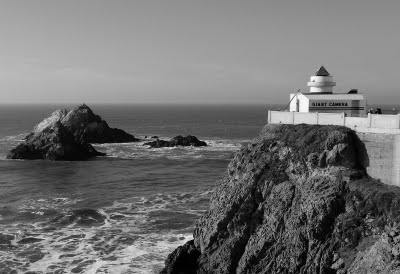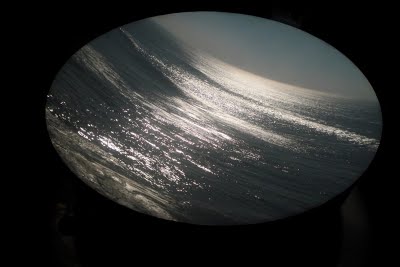
Camera Obscura
These essays are now also available in book form, printed on real paper
I love the West Coast. It is among the oldest coastlines in the world, and it looks it. This impression is confirmed with a look at maps of the way the continents have drifted, tumbled and collided around the globe over millions of years: the west coast of North America has always been pointed out, facing the huge expanse of the Pacific Ocean. In light if this, it seems to make a kind of poetic sense that the West Coast was the symbolic goal of the Manifest Destiny, the prize in the drive to conquer the North American continent and the frontier. I’ve always had this sense that the history of technology in California and the West was just an extension of the migratory drive westward of the American pioneers. The Pilgrims and their heirs achieved their Manifest Destiny, and the land has been conquered, for better or for worse. But now, with all the land gobbled up, what do we do with our insatiable drive to discover, to conquer? We keep going.
And where is there to go? Why, into space of course. Up into outer space, and down into inner space. Symbols of the extension of our frontier can be seen from the freeway which runs between San Francisco and San Jose. The most obvious is Stanford University’s massive radio telescope which towers over the 280 corridor. The Dish, as it is known around here, takes our drive to conquer and points it out to space. The Dish, and all the world’s telescopes and antennas, scan the next swath of territory, looking for signs among the stars that we can keep going. A mile down the freeway, for those who are driven to discovery on a different scale, is the SLAC National Accelerator Laboratory, the Dept. of Energy’s two-mile long linear accelerator, which runs under the freeway and plumbs microscopic space, searching for pathways to knowledge in between the atoms.
Most of us don’t get to go on these journeys–the pathways of science are as obscure to us as was the way west to Louis and Clark, before they started up the Missouri. We don’t understand the meaning of the intergalactic hiss that the Dish records or the significance of the images the Hubble takes, as beautiful as they are. We don’t know what to make of the dance of the charmed and strange particles that leave their trails on the target at the end of the particle accelerator. But when we see pictures of stars, or of scattered pieces of atoms, we take some comfort in the fact that someone is searching out new trails, that hidden truths may be revealed.
But I wonder if we are ever capable of arriving, of ending the journey. Having come to this place, to the edge, as it were, can we just appreciate it as a place? Can we ever stop searching and just see? Or is every place just a waypoint? Are we bound to urgently press on? I’m willing to accept that some are called to always search the horizon for new routes, but this straining impulse, this expectation that there is more to discover, more to do, is so deeply rooted in the psyche of everyone who has come to California that it is nearly a disease.
As an antidote to this straining, this looking beyond, there is a place on the coast near here where you are encouraged simply to see. Where you are not encouraged to map out new trails, or to imagine what lies over the horizon. Having arrived, you are invited just to see the beauty of it. In this place is a kind of old-school technology that is also an anti-technology. It’s a kind of camera, but one that doesn’t fill your shelf with albums or your hard drive with JPEGs. The images it produces do not require or even permit analysis. It is the Camera Obscura.
The Camera Obscura looks from the outside like a cheesy tourist spot: it is the Giant Camera of the old Playland at the Beach amusement park on the seaward side of San Francisco, built in 1946. But as cheesy as it looks, it is a thing of wonder: a dark room containing a six-foot wide parabolic wooden surface painted white that captures a projected image from outside without electricity, chemicals, or WiFi. The image is often moving, gently rotating with the turning of the lens which sits on top of the building, and as it is reflected via a prism down onto the table, we see the scene outside (the Cliff House behind the Camera, Seal Rock, the beach, and the open sea) panning and turning all at once on the circular surface. It can be a little disorienting, a bit hypnotic; it is certainly beautiful.
The round table on which the image is projected is about the same diameter as the target end of the two-mile long accelerator inside SLAC, as the sensor that hangs suspended in front of the Dish to catch it’s magnified space signals, and as the mirror in the Hubble Telescope. But the images it captures are less obscure than these, less abstract. What you see on the table in front of you in the Camera Obscura is immediate and intimate, it is the Place Where You Are. No interpretation is needed. You can’t study it, because it’s moving and changing and always different. You experience it.
A quick view with the lens at rest. The table is perfectly round, here viewed from the side.
Technology always promises access to things while simultaneously distancing you from them. The Television delivers programming from around the world but you are still stuck sitting in front of a glowing box in a darkened room. Jet airplanes can move you to the other side of the planet in hours, but you have no sense of the journey–of what you flew over, or through–only a sense of discomfort at having been squeezed into a tube and then squeezed out in a place where everything is different. The internet gives us access to all the world’s information, but requires us to keep our eyes fixed on a flat screen, and our ears plugged and wired.
The Camera Obscura, as a piece of technology, is no different, even if it operates on principles that have been understood for millennia: the image on the table is of the place where you are, but you are also not there. You’re inside a dark room looking at a projection of an image of the sea, not standing on the beach looking at the sea with your own eyes. Yet like all cameras, the Giant Camera of San Francisco helps you see things differently (or see them for the first time), and unlike the portable cameras we all carry, this camera preserves a feeling of immediacy and authenticity because the camera is bound to the place. You never really suffer that technology-induced isolation. You can hear the sea through the walls.
The Camera Obscura is also made of lovely, low-tech things: essentially glass and wood. A five-inch wide glass lens projecting on a six-foot wide table with a concave wood surface. Apart from the motor that turns the lens assembly, there is no electricity, no Intel Inside, no HD screen. In the Camera Obscura, you are the computer that processes the image, and if your capacity to remember hasn’t suffered too much from our culture of hyper-literacy, then you will recall this trip to the coast as a distinctly satisfying one.
Visit the Camera Obscura:
1096 Point Lobos Ave, San Francisco, 94121
37°46’41.64”N
122°30’51.22”W
(Satellite view): bit.ly/giantcamera


